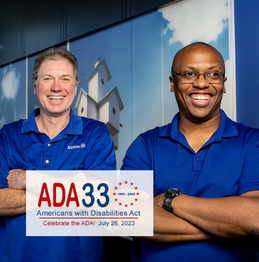
33 years ago on July 26, 1990, Congress passed the Americans with Disabilities Act (ADA). This historic civil rights law protects the rights of people with disabilities and prohibits discrimination against people with disabilities in several areas of public life, including employment, transportation, public accommodations, communications, and access to state and local government programs and services. The purpose of the ADA is to ensure people with disabilities have equal rights and opportunities. In honor of the ADA’s 33rd anniversary, below are tips for creating an inclusive workplace by fulfilling reasonable accommodations in the workplace and creating equitable employment opportunities.
Reasonable Accommodations in the Workplace
- Develop written policies and procedures: Employers should develop written reasonable accommodation policies and procedures for requesting and fulfilling accommodations. All staff should be informed of these policies and procedures.
- Appoint a responsible person or persons: Employers should decide who will be responsible for implementing and overseeing accommodation policies and procedures so all requests are reviewed and evaluated effectively and efficiently. The responsible persons should create an accommodation tracking system to document success.
- Don’t make assumptions: Do not automatically assume that many reasonable accommodations are unaffordable. Many accommodations are affordable or free. Do not assume that one accommodation will work for all individuals with similar disabilities.
- Ask for guidance: If the employer and applicant or employee are having difficulty determining the right accommodations, the US Department of Labor’s Job Accommodation Network may be able to provide free, confidential accommodation assistance.
Applicant Recruiting Process
- Respect is the foundation: Treat individuals with a disability with the same respect and dignity you would give any applicant.
- Evaluate candidates equitably: Do not assume certain jobs are more suited to persons with disabilities. Evaluate each candidate for the job based on whether they have met the employer’s requirements for the job, such as education, training, employment experience, skills or licenses.
- Challenge your perceptions: Consider whether a person with a disability can perform the essential functions of the job, with and without reasonable accommodation. Understand and recognize that there are often many ways to accomplish the same task.
- Create inclusive applications: Ensure that application forms and other relevant information are available in alternative formats and are compatible with assistive technology for people with visual or cognitive disabilities. Ensure application and other forms do not ask disability-related questions.
- Develop recruitment strategies specific to workers with disabilities: Include candidates with disabilities as part of overall diversity recruitment strategy. Participate in employment programs targeted at job seekers with disabilities. Use disability inclusion statements in job advertisements and career section of organization’s website.
Candidate Hiring Process
- Maintain confidentiality: Make sure that any disability-related information is kept confidential and shared only with those who need to know. Do not ask applicants about disability status during job interview. Supervisors and managers may be told about necessary restrictions on the work or duties of the employee and about necessary accommodations.
- Focus on the candidate’s merit: The focus of the hiring process should be on merit of the candidate and hiring managers should be willing to adapt the application or interview process to the candidate’s strengths.
- Check your assumptions: Never assume that people with disabilities lack the necessary education, training, experience, or skills for employment or that they are unable to perform the essential job functions. People with disabilities may do things differently, which could mean they fulfill their responsibilities more effectively and efficiently.
Employee Onboarding Process
- Ensure accessibility throughout onboarding: Create a virtual office tour to help new hires prepare for what they are about to experience to make the new environment less overstimulating. Test all training material against assistive technology to ensure accessibility. Share training materials in multiple formats like videos, written guides, etc.
- Create an inclusive workplace for all employees: Create an employee resource group and/or mentoring program for employees with disabilities. Offer disability etiquette interviewing skills training for recruiters and hiring managers. Do not assume the staff would need additional special training to learn how to work with people with disabilities. Do incorporate disability inclusion in your annual DEIA trainings for all staff.
Tilt your learning into action by implementing these tips in your own workplaces. Contact Lifeworks Diversity, Equity, and Inclusion department for support or more information.
Brittany Nguyen, DEI Intern
612-735-8540
bnguyen@lifeworks.org
Sources:
Tips for Onboarding and Training Employees With Disabilities – Accessibility.com
Best Practices: Creating an Inclusive Workforce – U.S. Department of Labor
Best Practices: Recruiting Students With Disabilities – National Organization on Disability
Developing an Accessible Workplace – Society for Human Resource Management
Credit for ADA Anniversary Logo:
ADA National Network (adata.org) 1-800-949-4232
